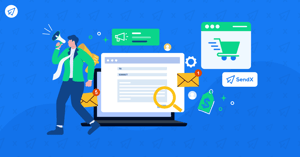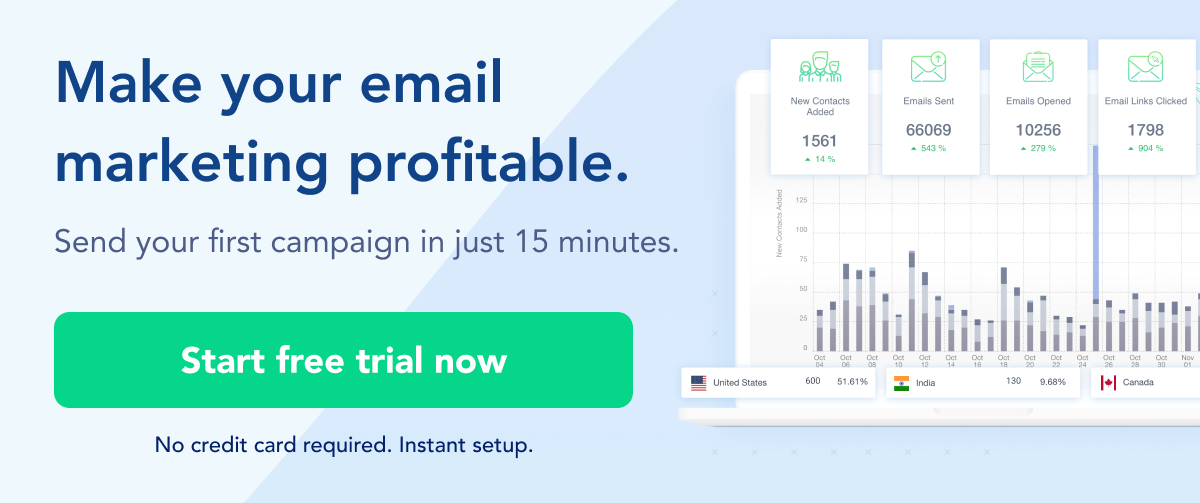
The Ultimate Guide To eCommerce Email Marketing Automation
eCommerce marketers are always hustling around the clock. They juggle multiple aspects like planning, launching, monitoring, and reporting marketing campaigns
Here’s where marketing automation becomes their knight in shining armor! The marketing pros offload their work using automation tools, saving them a lot of time to focus on ramping up their marketing ROI. According to Statista, the global marketing automation revenue is estimated to grow by 38.2% and reach $6.62 billion between 2021 and 2024.
What’s more?
Automation for email marketing, one of the most important marketing channels, has further helped folks refine their campaign’s output. Curious about email marketing automation for eCommerce businesses? Keep reading to learn more about its types, best practices, and some useful examples.
Table of Contents
What is eCommerce Email Marketing Automation?
Email automation is the act of creating emails and having them automatically sent to your email list based on the parameters you provide. It is used to send transactional and promotional emails as part of a larger email marketing plan.
Automated emails can be sent at certain times and triggered based on specific criteria. A recipient's newsletter subscription, purchase history, link clicks, time since their last purchase, and other factors may all serve as triggers. A typical automation example for transactional emails is sending a user an email with a shipping update or a password reset.
While email automation is reasonably simple to set up for businesses of all sizes, which contributes to email marketing's high ROI ($36 for every $1 spent), there are a few steps you must take before you can begin sending automated messages.
First, you'll need to use an email automation platform to send one-time messages and multi-message campaigns to your subscribers. We'll go over some of these below. Second, design email templates for automated campaigns that target certain audience segments.
Email automation, with the correct automation platform and high-quality message content, may help any e-commerce firm achieve exceptional results. It can assist in increasing your store's conversion rate, decreasing cart abandonment, improving the consumer experience, and more.
A good customer relationship management platform can comprehensively cover those email automation tasks. In addition, you can integrate this powerful tool with a chatbot. Tired of collecting emails manually? Salesbot from Kommo will help you to provide an opt-in email campaign to grow your email list. Then, make your interactive form or use a chatbot template and invite your customers to voluntarily participate in the email campaign. Thus, no more people mark your email automation campaign as spam.
Best Practices for E-commerce Email Marketing Automation
It is no secret that email marketing tools for Shopify have changed the game for several eCommerce businesses. In fact, a survey in February 2024 revealed that approximately 58% of marketing decision-makers reported automating their email marketing efforts. This made it the leading marketing channel to rely on automation.
However, the automation tools only prove to be useful when adhered to the following best practices:
1. Segmenting Your Audience
Email segmentation is the technique of categorizing your email recipients into smaller, more targeted groups and giving them the most relevant content. The smaller categories of potential customers are usually based on behavioral or demographic data — such as their state of residence, a previous purchase, or a task they completed on your website. Think of this activity as categorizing your team members based on their preferred mode of communication in the office - some prefer video conferencing while others prefer sending an email or a text message.
The segments can be as broad (for example, people who purchased a certain product from your Instagram shop) or as narrow (for example, Texas residents who signed up for your newsletter less than a day ago) as you like. However, the smaller they are, the more direct and targeted your content should be, and the greater the likelihood that it will resonate with the recipients.
2. Personalization Techniques
The primary goal of email marketing segmentation is also its most significant benefit: personalization. If you get your email marketing segmentation right, your clients will receive relevant emails full of information that they want. Personalization increases conversions, purchases, and customer satisfaction.
Email personalization for eCommerce goes beyond simply starting your email with the recipient's name. It can go as far as tracking your customer's purchase history and offering relevant products to provide a smooth purchasing experience. So, once you've segmented your audience into several groups, you can begin by developing multiple email variations for each part.
90% of U.S. consumers find marketing content personalization “very” or “somewhat” appealing
3. Creating Dynamic Content
We already know that personalization increases conversions.
The same can be said about dynamic content, a type of personalization that has been demonstrated to enhance email ROI by 100%!
What is dynamic content, exactly?
Dynamic content generates individualized content based on user signals. Product recommendations are based on previously purchased or watched products. Calls to action are matched to the user's browsing habits.
Free exclusive offers (such as ebooks and white papers) for those in the "research" stage of the buying process.
Most big email marketing tools for Shopify providers will consider dynamic content to be an excellent addition to most eCommerce email marketing templates.
4. Timing and Frequency
Let's be honest: everyone's email inbox is full of unread messages. On average, two-thirds of people have 1602 unopened emails in their inbox.
How do you plan campaigns in an era when emails are ignored? It is fair to assume that emails at the top of your inbox will be viewed and opened. So you must time them correctly.
Sending an email at the proper moment can potentially boost your email campaign's success rate. Timing the messaging correctly allows you to stay relevant, be viewed more frequently, and engage with your subscribers more effectively.
5. A/B Testing
Once you've created a timetable, remember that it's not set in stone. A/B testing your email send times is vital for continually determining the sweet spot for your audience.
You can send one email and another at separate times. Then, compare open rates, conversions, and other metrics to determine which hour was the most effective.
Do this frequently because the optimal time may change, and it is critical to continue changing and learning what works and what does not.
Types of E-commerce Email Marketing Automation
Here are five kinds of e-commerce email marketing automation that we believe will benefit practically all e-commerce businesses. The best part is that they're all simple to set up with email marketing tools for Shopify.
1. Welcome Emails
Every e-commerce store requires a welcoming email. It is the first email you send when someone subscribes to your email list, and it guarantees that potential consumers begin their journey with you in the proper way. Here’s an example of a good welcome email. It checks the following boxes that help create a genuine rapport with a new visitor:
- Provide key facts about your brand.
- Link to your top products.
- Explain the kind of stuff you'll send.
- Provide details about what makes your brand stand out.
- Provide an incentive for new members, such as a discount voucher.
2. Abandoned Cart Emails
Abandonment cart email marketing tools for Shopify allow you to follow up with subscribers who started the checkout process but did not complete it. When attempting to generate income for your company, it is important to begin by optimizing your current sales funnels and maximizing revenue from existing clients.
Acquiring new clients is 5 times more expensive and 3 - 12 times more difficult than selling to existing customers. This is because existing clients have already interacted with your eCommerce brand and are familiar with its services.
While cart abandoners aren't technically existing customers, the same general logic applies: they're easier to convert because they've already moved down your sales funnel. By sending targeted abandoned cart reminder emails, you can re-engage these potential consumers and guide them to complete their purchases.
This strategy enables you to capitalize on existing interest and recoup possibly lost revenue without incurring the additional expenditures associated with gaining new consumers. Here’s an interesting example of an abandoned cart email from Dyson. As you will observe it hits the spot when trying to urge the customers to finish placing their while not being too pushy.
3. Product Recommendation Emails
Sending product recommendations to your clients demonstrates that you care about their needs and appreciate their support. However, if you do not personalize your advice, you will quickly make mistakes. So, how do you do that?
Use their browsing history and previous purchases to recommend things that complement or are comparable to what they've purchased, as well as what other consumers bought after purchasing the same product.
Product recommendations can be used as a solo sequence or as part of a larger campaign or workflow. Testing and content optimization can help you determine which is most effective for your clients.
Upselling occurs when you market an extra product that is connected to the one a customer has recently purchased (cross-sell) or is in the process of purchasing. Another effective strategy is product bundling, where complementary items are offered together as a package deal. For example, if a consumer buys your protein powder, you try to persuade them to also purchase your shaker cup or blender. To develop upsell emails, you must first determine which goods to upsell, when to upsell, and how to upsell them.
Begin by identifying complementary products. You can categorize related products based on intuition or based on actual data about what things people buy together. In the following example, you can see how Amazon has smoothly added product recommendations in their email:
4. Post-Purchase Follow-ups
Post-purchase emails are messages sent to customers after they purchase from your store. There are many various types of emails, including transactional emails like shipping confirmations and delivery updates, as well as marketing emails like thank-you notes and surveys.
What you send after a transaction is dependent on your product and brand. Consider the types of material that new customers would benefit from, and add that information.
This might be:
- User Guides
- Community invitations
- Information about loyalty programs.
- Invites you to follow social outlets.
- Styling tips
Remember that you don't have to stick to stuffing it all in a single email; you may design a drip sequence that addresses all of your customers' needs.
5. Re-engagement Campaigns
If your emails aren't valuable to your readers, they may eventually start to ignore them. Many subscribers do not receive your emails because their contact information is out of date.
If your open rate is starting to drop, a re-engagement or "win back" email series can assist. These emails are all about knowing what motivates customers to connect with your emails, confirming contact information, and reigniting subscribers' interest. There are various techniques. You can provide product recommendations and discounts, ask readers to confirm their email addresses if they enjoy your content, and so on.
In a Nutshell
Before you begin increasing visitors to your online store, you must first implement these five types of email marketing automation. You can dismiss the campaigns (newsletters) that must be sent weekly or monthly, but email marketing automation is essential.
As I constantly tell my customers, you must commit your time and resources, and the system will work for you repeatedly with no more effort. It doesn't have to be flawless; you can always make improvements later. However, it is necessary because it allows you the ability to focus on bringing traffic to your store.



